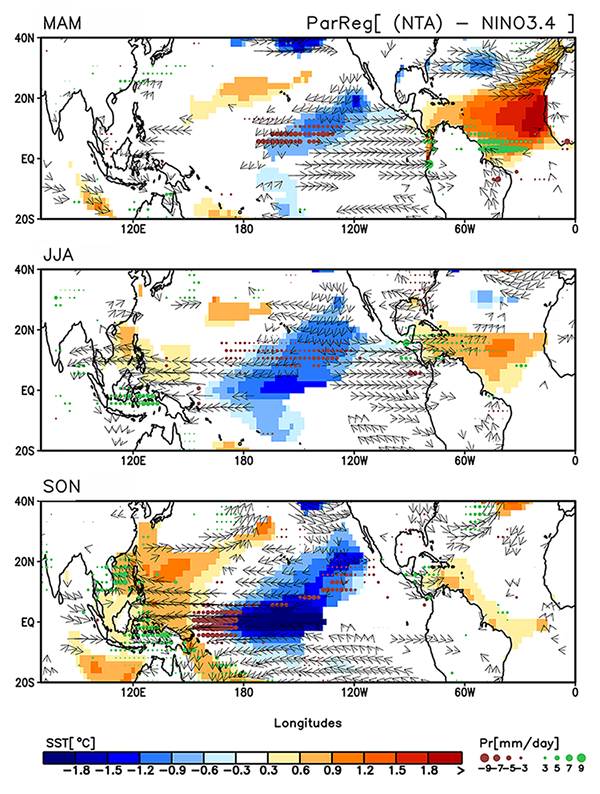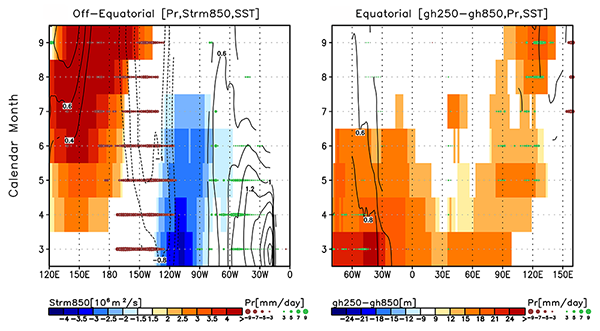Diagnosing Teleconnections between SSTs in the Tropical North Atlantic and ENSO Events
Yoo-Geun Ham January 2013
Although it's well-known that El Niñ0/Southern Oscillation (ENSO) events can influence the weather and sea surface temperatures (SSTs) in ocean basins outside of the tropical Pacific, only recently have the influences of the tropical Atlantic on the ENSO cycle been explored. In a recent study (Ham et al., 2013), data from MERRA and other sources were analyzed in order to identify how anomalously warm SSTs in the northern tropical Atlantic (NTA, here referred to as the region 90° W - 20° E, 0° - 15° N) influence ENSO variability by teleconnections.
To assess the impact that anomalously warm SSTs in the NTA have on ENSO, we analyzed monthly mean wind, geopotential height, and precipitation data from MERRA for the thirty years from 1980 to 2010, along with SST, subsurface temperature, ocean currents, and vertical velocity data from NCEP ocean reanalyses. Since NTA SSTs are known to be influenced, with a few months. lag, by ENSO variability, ENSO's effect had to be removed from the analysis. For that, a linear regression was performed with respect to NINO3.4 SSTs (the NINO3.4 region is 170° - 120° W, 5° S - 5° N) for the December, January, and February (DJF) season of the previous year and subtracted from a lagged regression, with respect to NTA SSTs, for the February, March, and April (FMA) season. The results, summarized in Figure 1, show that warm SSTs in the NTA in the northern hemisphere spring can remotely influence ENSO variability, leading to a La Niña event the following winter.

click for larger image
Anomalously warm SSTs in the NTA in March, April, and May (MAM), were found to result in enhanced convective activity, and therefore enhanced diabatic heating, especially over the equatorial Atlantic. In response, a low level cyclonic circulation develops in the subtropical eastern Pacific, thereby creating a northerly flow at the west flank of the circulation that results in surface cooling from both the enhanced winds, and from the advection of colder/drier air from higher latitudes. This cold, dry air acts to suppress convection and precipitation, and creates a clear area in part of the subtropical Pacific. During the boreal summer months of June, July, and August (JJA), the area of suppressed convection moves north with the typical northward migration of the Pacific Intertropical Convergence Zone (ITCZ), and generates a low level anticyclonic circulation that enhances the northerly flow already present on its eastern flank, thereby reinforcing the subsidence.
As the summer progresses, the negative precipitation anomaly and associated anticyclonic flow that are created by the subsidence induced by enhanced northerly flow expands westward and induces an easterly flow over the western Pacific at the equator, generating an upwelling Kelvin wave that cools SSTs in the equatorial Pacific, and possibly making conditions favorable for a La Niña event. Westerly winds over the eastern Pacific suppress upwelling. Hence, cold SSTs are therefore mainly confined over the central Pacific.
Analysis of MERRA data has shown (Figure 2) that warm SSTs in the NTA can also modulate SSTs in the equatorial Pacific by impacting geopotential heights, or atmospheric thickness (hereafter thickness). Warm SSTs in the NTA are associated with a positive thickness anomaly that propagates eastward, past the Indian Ocean. The thickness anomalies are associated with a low-level low-pressure anomaly. This anomaly induces an easterly flow that generates upwelling Kelvin waves in the equatorial Pacific.

click for larger image
In the eastern Pacific the local and remote response of SST through both mechanisms are of opposite sign and the response to the NTA is small. Under the influence of both mechanisms, the SST response is mainly confined to the central Pacific.
This investigation of reanalysis data has been verified by a modeling study in which ocean-atmosphere coupled global circulation models (CGCMs) were run with prescribed SST fields, where the only difference between runs was the SST anomaly over the NTA. In runs where the NTA SSTs were warm in the spring season, a La Niña event was more likely to take place the following winter than in the control, and the La Niña event had a high probability of being strong. In instances where an El Niño event was underway when NTA SSTs warmed, that El Niño event was more likely to be terminated early than in the control. In simulations where SSTs in the NTA were anomalously cool, an El Niño event was more likely to develop, but unlike a canonical El Niño event, the warm SST anomaly was more likely to be located in the central Pacific.
MERRA Data Holdings - http://disc.sci.gsfc.nasa.gov/daac-bin/DataHoldings.pl
Reference
Ham, Y-G., J-S. Kug, J-Y. Park, and F-F. Jin, 2013: Sea surface temperature in the north tropical Atlantic as a trigger for El Niño/Southern Oscillation events. Nat. Geosci., doi: 10.1038/ngeo1686. doi:10.1038/ngeo1686.
« Climate Diagnostics and Prediction
« GMAO Research Highlights

